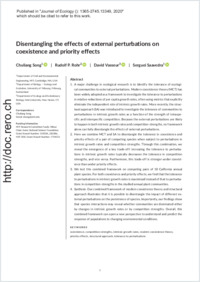Disentangling the effects of external perturbations on coexistence and priority effects
- Song, Chuliang Department of Civil and Environmental Engineering MIT Cambridge MA USA
- Rohr, Rudolf P. Department of Biology – Ecology and Evolution University of Fribourg Fribourg Switzerland
- Vasseur, David Department of Ecology and Evolutionary Biology Yale University New Haven CT USA
- Saavedra, Serguei Department of Civil and Environmental Engineering MIT Cambridge MA USA
-
26.02.2020
Published in:
- Journal of Ecology. - 2020, p. 1365-2745.13349
English
A major challenge in ecological research is to identify the tolerance of ecological communities to external perturbations. Modern coexistence theory (MCT) has been widely adopted as a framework to investigate the tolerance to perturbations in relative reductions of per capita growth rates, often using metrics that explicitly eliminate the independent role of intrinsic growth rates. More recently, the structural approach (SA) was introduced to investigate the tolerance of communities to perturbations in intrinsic growth rates as a function of the strength of intraspecific and interspecific competition. Because the external perturbations are likely to happen in both intrinsic growth rates and competition strengths, no framework alone can fully disentangle the effects of external perturbations.Here we combine MCT and SA to disentangle the tolerance in coexistence and priority effects of a pair of competing species when subject to perturbations in intrinsic growth rates and competition strengths. Through this combination, we reveal the emergence of a key trade‐off: increasing the tolerance to perturbations in intrinsic growth rates typically decreases the tolerance in competition strengths, and vice versa. Furthermore, this trade‐off is stronger under coexistence than under priority effects.We test this combined framework on competing pairs of 18 California annual plant species. For both coexistence and priority effects, we find that the tolerance to perturbations in intrinsic growth rates is maximized instead of that to perturbations in competition strengths in the studied annual plant communities.Synthesis. Our combined framework of modern coexistence theory and structural approach illustrates that it is possible to disentangle the impact of different external perturbations on the persistence of species. Importantly, our findings show that species interactions may reveal whether communities are dominated either by changes in intrinsic growth rates or by competition strengths. Overall, this combined framework can open a new perspective to understand and predict the response of populations to changing environmental conditions.
- Faculty
- Faculté des sciences et de médecine
- Department
- Département de Biologie
- Language
-
- English
- Classification
- Biological sciences
- License
-
License undefined
- Identifiers
-
- RERO DOC 328404
- DOI 10.1111/1365-2745.13349
- Persistent URL
- https://folia.unifr.ch/unifr/documents/308391
Other files
Statistics
Document views: 198
File downloads:
- pdf: 256
- Supplementary material: 173

